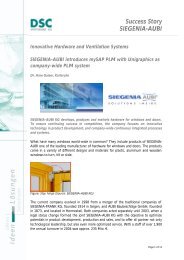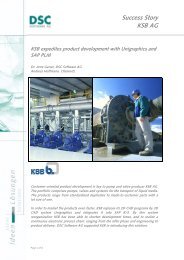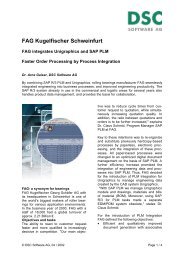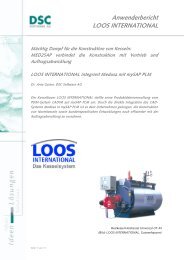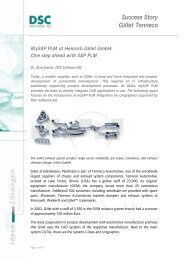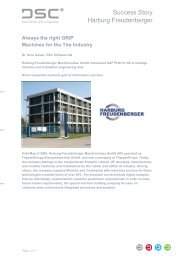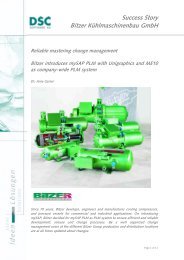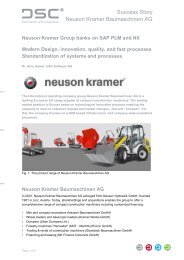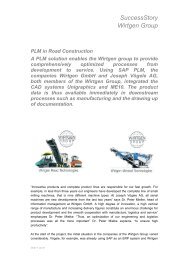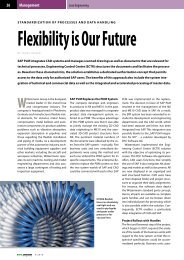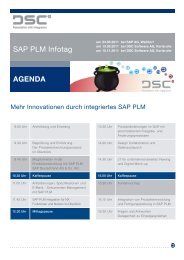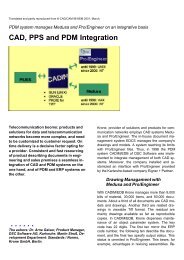VA TECH ESCHER WYSS GmbH Ravensburg - DSC Software AG
VA TECH ESCHER WYSS GmbH Ravensburg - DSC Software AG
VA TECH ESCHER WYSS GmbH Ravensburg - DSC Software AG
Create successful ePaper yourself
Turn your PDF publications into a flip-book with our unique Google optimized e-Paper software.
CAD. <strong>VA</strong> <strong>TECH</strong> uses the TIFF format for this<br />
purpose.<br />
Moreover, this TIFF format allows users<br />
prompt access to the latest drawings without<br />
using the Unigraphics software. Creation of<br />
TIFF files is incorporated in a release process<br />
and is the result of status modifications. The<br />
TIFF file is then saved under the same document<br />
info record as the original Unigraphics<br />
drawing.<br />
Release and modification strategies<br />
In the course of order processing, data and<br />
information is often adapted and modified. So<br />
as to provide unambiguous proof of "verifier",<br />
"date of verification", "releasing person" and<br />
"date of release" – even within the scope of<br />
product liability – this information is noted<br />
down on the drawing. Formerly, the staff was<br />
ultimately responsible for drawing up the <strong>VA</strong><br />
<strong>TECH</strong> guidelines for controlling, verifying and<br />
approving drawings and documents as well as<br />
for checking compliance with them. After introducing<br />
PLM integration for Unigraphics, the<br />
SAP system and the processes selected<br />
therein have become responsible for compliance<br />
with certain release<br />
procedures. This means<br />
that the procedures remain<br />
reproducible and comprehensible.<br />
The solution to this problem<br />
was a combined updating<br />
and TIFF file creation<br />
process that is automatically<br />
started at particular<br />
status transfers. For<br />
this purpose a status network<br />
was introduced as the<br />
basis for all document<br />
types. It determines the<br />
positions the document is<br />
to run through prior to its<br />
release and who is entitled<br />
to a status change. Verifications,<br />
approvals and<br />
releases can only be performed<br />
by people authorized<br />
to do so. Altogether 5<br />
release strategies were defined and a release<br />
strategy assigned to each of the 15 types of<br />
documents.<br />
Abbr. Meaning Procedure<br />
AA Work request<br />
IA In work<br />
ZU Accessible<br />
SZ Lock – accessible<br />
EF Released by origi- TIFF file creanatortion<br />
PT Verified - Engi- TIFF file creaneeringtion<br />
PA Verified - Order TIFF file crea-<br />
processing tion<br />
GE Approved TIFF file creation<br />
FR Released<br />
SS Lock release<br />
ZG Rejected<br />
For documents HZG (auxiliary drawings) only a<br />
release by the originator is required. There are<br />
no further verifications and approvals. For<br />
documents type HZN (design drawings), however,<br />
the requirements are more comprehensive:<br />
Here both verification and approval by the<br />
Engineering Department as well as verification<br />
by the group manager or the head of the department<br />
are required. The drawing can only<br />
be released by the segment leader.<br />
Illustration: Status network / Release strategy<br />
for document types - Auxiliary drawings<br />
(above) and Design drawings (below)<br />
© <strong>DSC</strong> <strong>Software</strong> <strong>AG</strong>, 07/2002 Page 6 / 8



